It’s a classic to say that two people who don’t get along ‘fight like cats and dogs,’ but this well-known adversity can be frustrating when it comes to your pets picking fights, particularly if your dog is bothering your cat.
Your dog will not leave your cat alone because the typical feline response to being scared, by barking, for example, is to run, and your dog’s instinct is to chase fleeing ‘prey.’ Even a bad interaction can create years-long distrust and unease between your dog and cat.
This article will cover how to break up a fight between a cat and a dog and tips on getting your canine and feline best friends to co-exist.
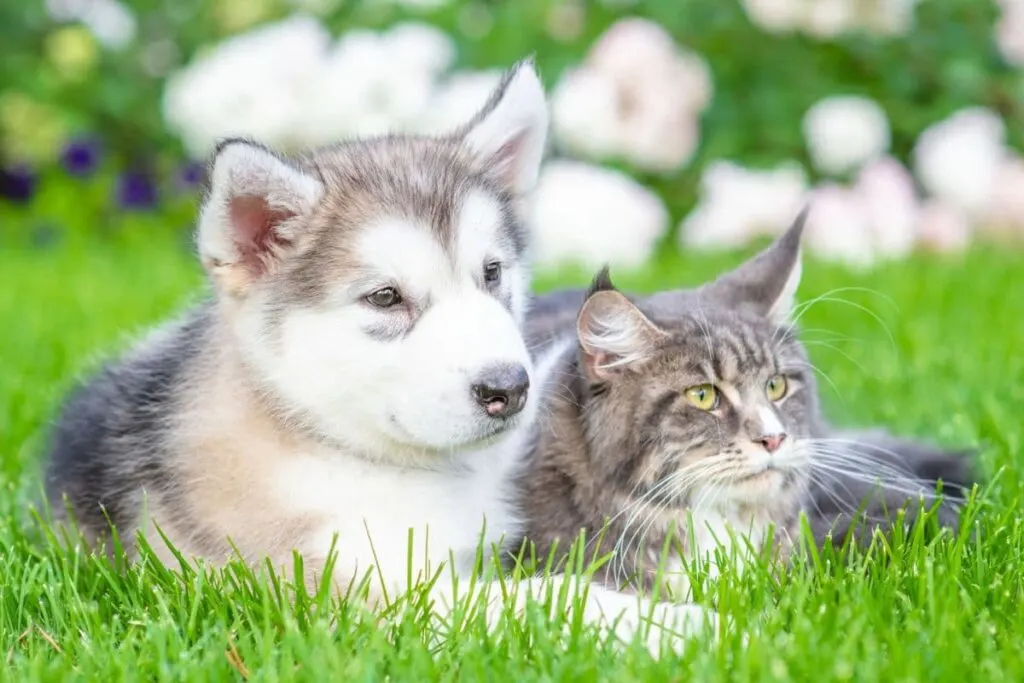
Click Here to Jump to a Section
How To Get Your Dog Away From Your Cat
A fight between a cat and a dog typically involves the latter barking at or even chasing the former.
Then, when the cat runs, your dog sees potential prey and gets more excited and fixated on the feline, making the cat scared and more likely to lash out.
In the case of any fight, you need to intervene quickly and calmly to separate the two animals before one gets hurt.
While your first instinct may be to get between the fighting pets yourself, this is dangerous and not something you should attempt.
Instead, your best bet is to focus on getting your dog away or re-directing the canine’s attention.
There are a few ways you can do this, such as:
- Make a loud noise to startle the dog (and cat) to distract them.
- If your dog is on a leash, pull them back and away from the cat.
- Slide a barrier between the two animals, such as a baby gate or a large piece of cardboard, keeping yourself to the side.
- Splash your dog with water.
- Throw a blanket over your dog.
You can also use the ‘wheelbarrow’ method of grabbing your dog by the hind legs and pulling them away, though this does put you at risk of being bitten and, depending on your canine’s size, may require two people.
Should You Try To Get to Your Cat First When Breaking Up a Fight?
Just like your first thought might be to get between the animals to stop a fight, you may wonder if it is better to try to get your cat away from your dog.
After all, picking up the (usually) smaller feline would seem more straightforward.
However, not only might your dog continue to go after your cat while you are holding the feline, there’s the risk of the scared cat lashing out at you in defense.
While injuries from dogs might look worse and be larger, a bite from a cat has a high risk of getting infected due to the bacteria in their mouths.
If your cat bites you or gives you a deep scratch, you need to get medical attention as soon as possible.
The doctor will likely prescribe at least one antibiotic and give you a tetanus shot.
From personal experience, though gained from getting a cat unstuck and not breaking up a fight, a full-force cat bite is painful, and my treatment involved:
- Three antibiotics
- The mentioned tetanus shot
- Almost a week of barely being able to use my arm to hold any weight from the puncture wound.
Of course, a doctor should also treat severe wounds from dogs, but those wounds aren’t as likely to get infected.
Let your cat run away to a safe spot, and focus on getting your dog under control first.
Why Do Dogs and Cats Tend To Not Get Along?
Aside from the prey-chasing aspect already mentioned, there are multiple reasons why cats and dogs tend to fight.
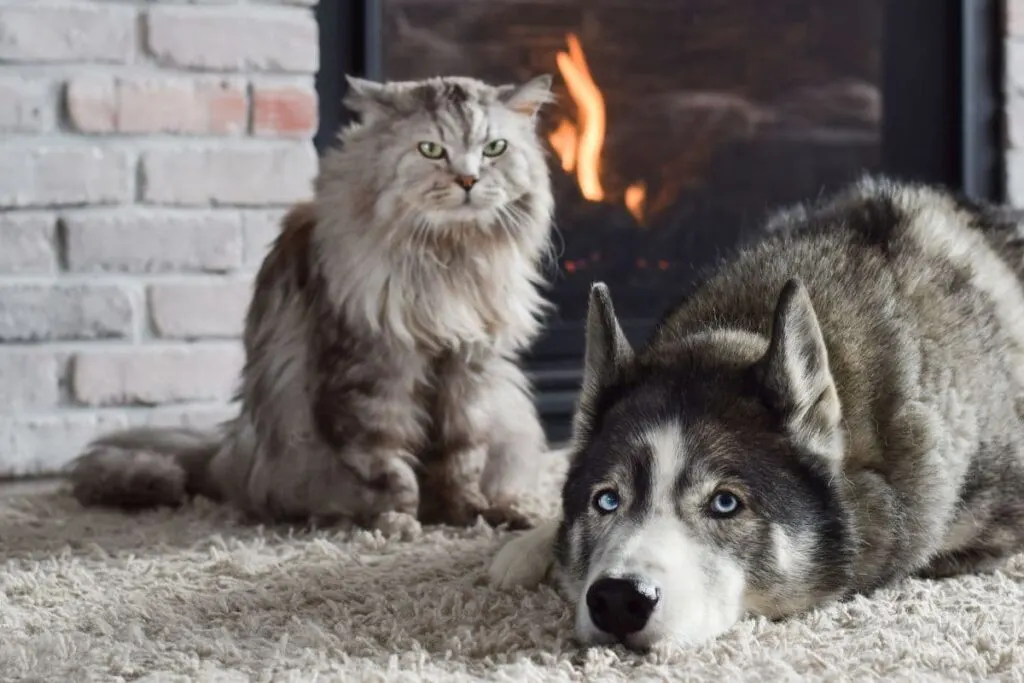
One is that while dogs are pack creatures, cats are more solitary.
Cats, being smaller, are also easy to spook.
Another reason is that both animals can be territorial and like their regular habits and schedules, creating conflict – especially when a new dog or cat is brought into the mix.
In addition, multiple behavioral differences can lead to misunderstandings between canines and felines.
For example, dogs wag their tails when happy, play rough, and tend to have lots more energy than a cat.
Felines, on the other hand, lash their tails side-to-side when angry or annoyed, run when scared, and prefer to interact on their own terms.
A dog might mistake their purring as a type of growling and their tail “wags” as playful.
How To Get Dogs and Cats To Get Along
The key thing when it comes to getting a cat and dog to at least tolerate the other is introducing them properly.
A correct pet introduction may take several weeks, especially since you’ll want to go at your cat’s pace.
Here are the basic steps to follow when you bring a new cat or dog into your home:
1. Keep the animals in separate areas of the house at first, using a barrier like a baby gate so they can see and sniff each other if interested but not fight and hurt the other.
You may want to start with a simple, closed door before moving to something the animals can see through.
2. Let them get used to the other’s scent by putting items the dog or cat has used, such as toys, in the other’s area.
3. Set their food bowls next to the barrier so that they associate the other with something positive.
However, once both animals are in the same space, you should separate their food to avoid potential food aggression, particularly from your dog.
4. When you first have the dog and cat in the same room, keep your dog on a leash and under your control.
Make sure your dog follows basic commands, and if the canine acts up, simply step away from the cat instead of scolding your dog (since you don’t want your canine to associate the cat with getting in trouble.)
5. You will probably need to separate the two again after the first introduction and repeat step 4 multiple times over weeks before your cat feels comfortable around your dog.
If you are worried that your dog might get too excited, you can exercise them before the introduction so they have less energy and will be calmer.
Even once you’ve successfully introduced your two pets, you’ll want to monitor the interactions until you’re confident there will be no fights.
You’ll also want to ensure that your cat has safe spots – places where the dog can’t reach, such as cat towers – to escape to, and this includes the litter box and cat food being in a feline-only space.
What Not To Do
The main thing you want to avoid is plopping your new cat down in front of your dog for the latter to sniff or letting a new dog run free in the house and upset the resident cat.
You also don’t want to force interactions; give your pets – particularly the feline – the time they need to get used to each other.
Bad first impressions can lead to years of mistrust between your companions, so it’s best to avoid them.
What if You Didn’t Introduce Your Pets Correctly?
It may be that you accidentally messed up the first introduction between your dog and cat, and in that case, you might be worried that you’ve removed any chance of the two getting along.
It’s never too late to work to get canines and felines to tolerate each other.
You can use the above introduction steps to help them become more comfortable around each other, even if they’ve been in the same house for years.
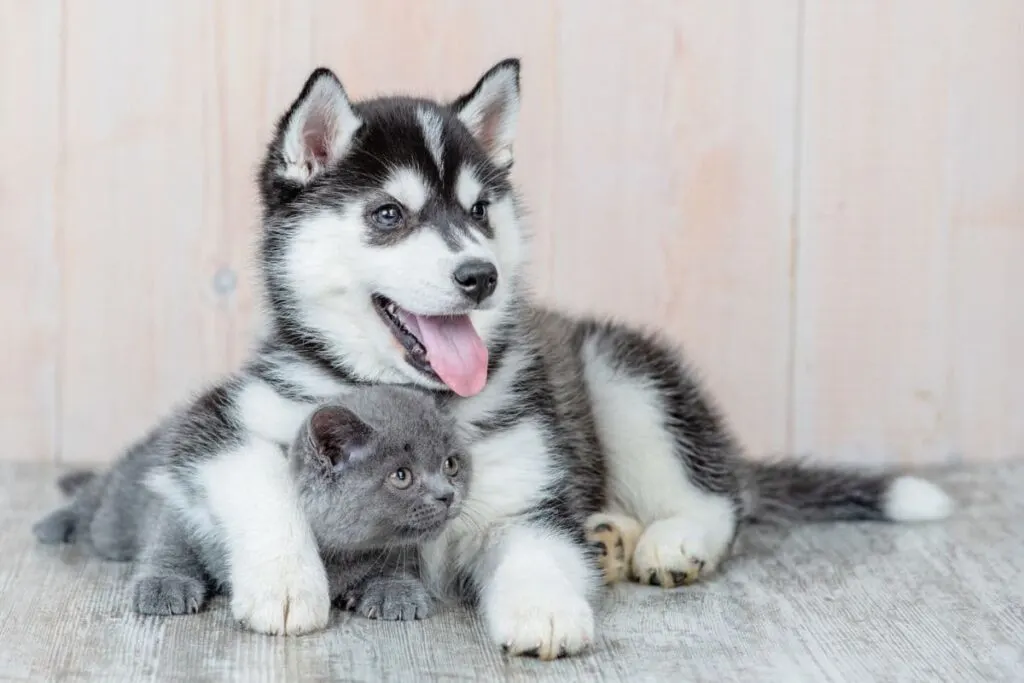
Training your dog to be calmer around the cat, and giving the feline areas that are dog-proof, can decrease the tension, though they will probably not develop a close friendship.
Is There a Best Time in a Dog’s or Cat’s Life To Introduce Them to Other Pets?
The best time to introduce a cat to a dog, or vice versa, is when they are both young and learning to socialize.
For kittens, this is when they are between four to eight weeks old; five to twelve weeks for puppies.
Older pets can still learn to get along, though it might be easier in some cases than others.
For example, a puppy might annoy an older cat, and while a kitten could be fearless around an adult dog, the latter could accidentally hurt the feline.
How To Get Your Cat and Dog To Bond
You can help your pets bond by creating positive interactions between the two, even if that’s being in the same room but not interacting.
As mentioned in the introduction steps (and since smell is such an important sense for both mammals), letting them sniff the other’s toys or beds will help your pets get used to each other.
Since it will likely be your dog that starts most fights, you can also reward the canine when it ignores the cat.
How To Prevent Bad Behavior From Your Dog Towards Your Cat
The primary way to prevent bad behavior from your dog is to train it to ensure it will follow basic commands, especially ‘sit’ and any versions of ‘leave it.’
It is also a good idea to learn signs of potential aggression from your dog, as it can give you a heads-up to pay closer attention or preemptively separate your pets before a fight breaks out.
Here are some signs that your dog might become aggressive:
- Stiff body language
- Pulled-back lips
- Acting more dominant
- Barking and growling
- Fixating on the cat.
Having your pets spayed or fixed can help lower their overall aggression.
While cats can also pick fights, it’s much more unlikely unless they are territorial or scared.
A loud noise or spray bottle can be a useful distraction or deterrent for your cat, though you should still focus on getting your dog away first.
For more information, you can also check out my article on what to do if your dog gets a sore throat from barking. [Can Dogs Get a Sore Throat from Barking Too Much?]
There I’ve discussed tips on how to calm down dogs which can potentially help you out in this scenario.
What if Your Pets Refuse To Get Along?
Sometimes, it doesn’t matter what you try; your dog and cat may never get along.
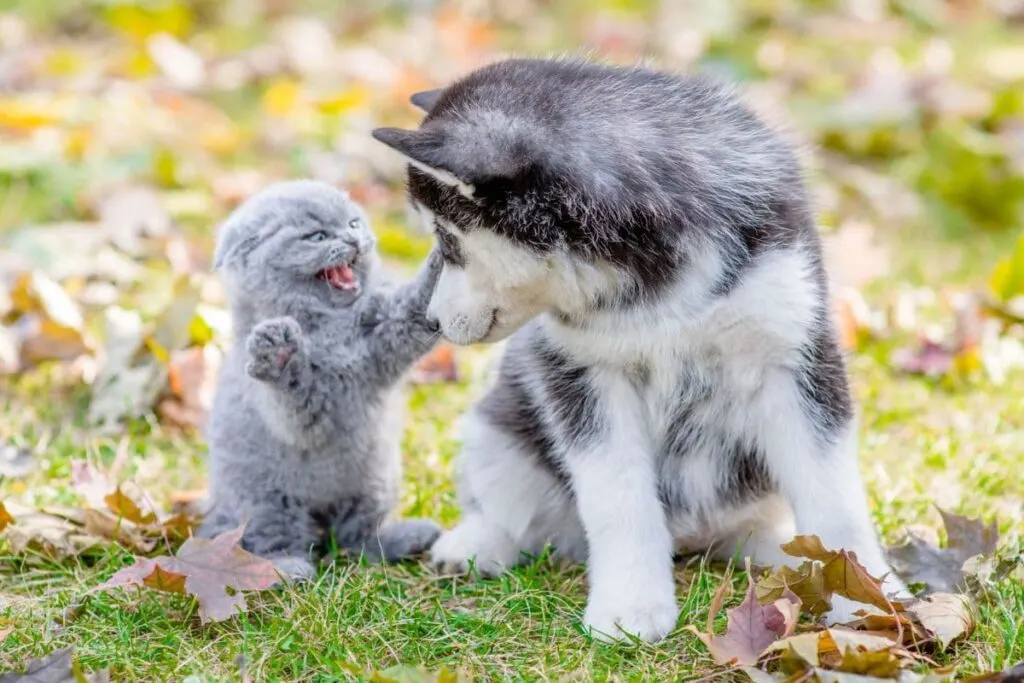
Tolerance and a peaceful co-existence should be your goal, not a picture-perfect friendship, yet even that isn’t always possible.
In this case, you may have to keep your pets permanently separated.
Baby gates or keeping your dog crated when you aren’t around to supervise are two options to keep your dog and cat separated.
In other cases, the best choice for you and your companions may be to re-home one, typically whichever pet is the newest to the house.
Re-homing should always be a last resort, however, as it can cause serious emotional damage to the animal.
Do Some Dogs and Cats Get Along Better Than Others?
If you plan on having both felines and canines in your life, there are ways to increase your odds that the two species will be able to get along with the other better.
One way is to pay attention to the breed of the pet, as some dogs or cats generally get along with the other better.
With canines, you will probably want to avoid breeds that have a history of being used as hunting, herding, or guard dogs.
Toy or sports dog breeds are more likely to be less aggressive toward cats, such as beagles and pugs.
There are also some cat breeds that are known to be more canine-accepting than others, such as Ragdolls, Maine Coons, and British shorthairs.
But more important than breed is personality.
An easily annoyed cat is not a good option if you have a hyper dog.
On the other hand, a more playful feline might enjoy a canine companion.
Finally, when adopting a pet, ask about their history with other animals, as many shelters will list if a dog is good with cats or if a cat has lived with dogs before.
After all, part of ensuring an animal has the best chance of staying in its new home is ensuring potential caretakers know how their new pets will react to other family members.
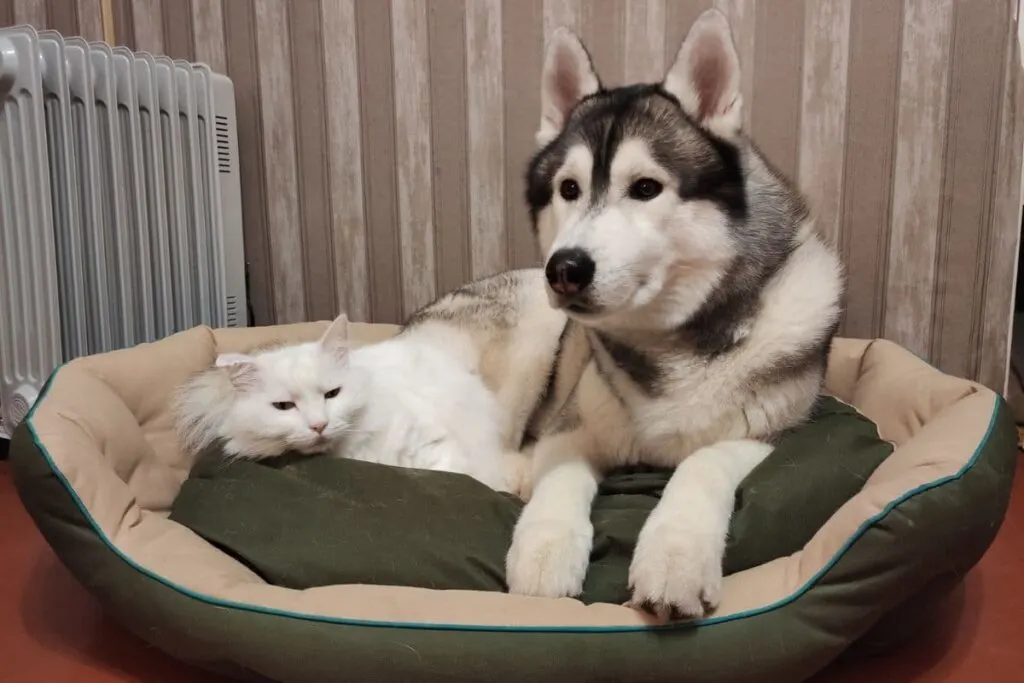
Conclusion
Many species differences are the main reasons why dogs and cats don’t get along.
If a fight breaks out between your pets, focus on getting the canine under control before worrying about your cat.
With a proper introduction and ensuring that your dog is well-trained, you can typically get cats and dogs to co-exist and ignore each other.
Knowing a new pet’s history and personality are two great ways to increase the odds that your cat or dog will fit in with the rest of the family.
